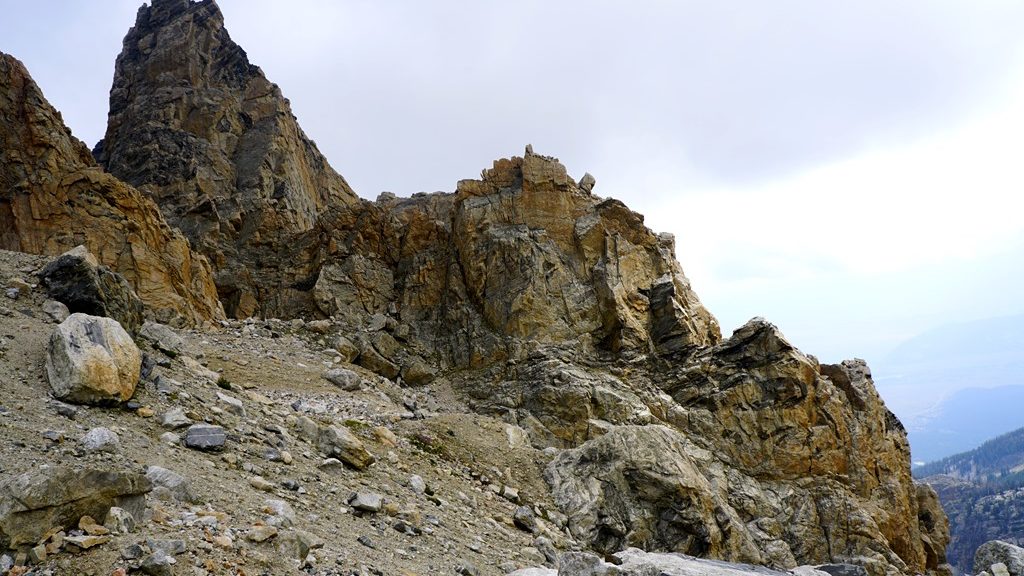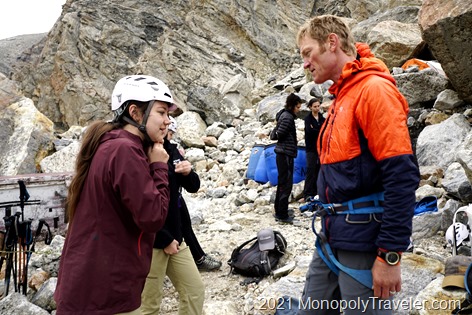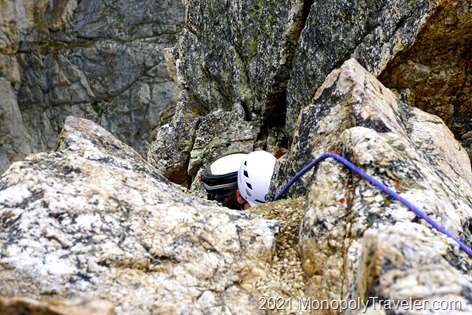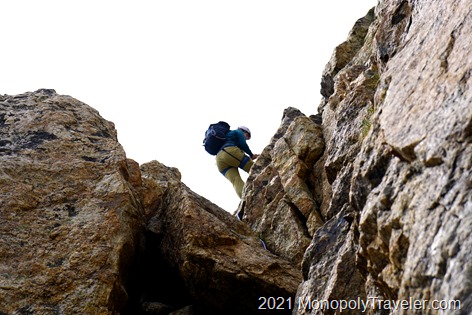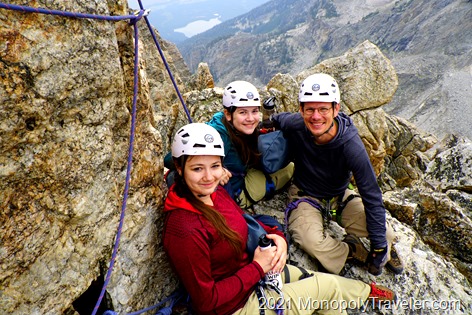It was Saturday morning, the day after hiking 7 miles and gaining around 5,000 feet in elevation. The rain and wind had been pounding at our tents for much of the night but now had settled down. This was to be our training day in the mountains with breakfast starting us off at 8am. We were all tired and quite stiff, unsure of how much energy our bodies still had for climbing activities but we were here and wanted to climb Grand. With this motivation we got dressed and collected near the Kitchen – a larger tent with a rounded roof for hot breakfast burritos to start the day. It was cloudy and cool but at least the rain wasn’t falling. For how long we weren’t sure as the forecast called for more storms to develop as the afternoon continued so we needed to take advantage of the dry morning.
The first step was getting climbing gear fitted and put on which included day packs, helmet, harness, and carabineers to attach ropes to. Everything we would bring with the next day for our main climb. My expectation for this day was to fit our gear and an introduction on how to use it including attaching ropes, terminology, and climbing techniques on rocks or boulders nearby. Once the gear was on and tightened correctly we headed for a few boulders just above us to begin to learn how to use and trust our approach shoes. These were new to all of us so I didn’t realize the bottoms of these shoes have different tread for different climbing uses. Our guide showed us what these different treads were for and then headed for a rock slab to put them to use. None of us were ready to work on this slab as it was still wet from rain the night before. There’s no way we would get up it without slipping and injuring something. After a lot of convincing from our trusted guides, we began to move up and down the slab using techniques and body position to move up and down this slab sticking to it with our rubber bottomed shoes even though it was wet. From here we moved on to a boulder which had a square corner and again used climbing techniques with body position to locate hand and foot holds which at first didn’t appear to be there. Amazing how we learned to move up and down this rock also!
Soon we were on a trail to the peaks in the top photo. Arriving at the base, our guides began to pull out ropes and remove a few layers of clothing in preparation for teaching us how to go up the mountain. Taking this lead, we also began to remove a few layers as we would begin working more and getting quite warm. At this time it was a good opportunity to drink some water and eat something. You burn a lot of calories while climbing and require more water to remain hydrated in the dry mountain air. In a few minutes we were all attached to ropes and instructed on the path to take up this steep rock. From a distance these peaks appear to be straight up and down and quite intimidating. Once you begin to study them up close you can often find paths using ledges and crevices and begin to figure out how to move towards the top. Again, trusting our guides, we tried to follow their paths and all worked together to locate places to put our hands and feet that were secure in order to push ourselves up the rock. Even though we were attached by ropes, none of us was interested in seeing how well they were holding us and relied solely on our hand and foot holds. I didn’t really expect to get into this level of training. It almost felt as though we were thrown right into some major mountaineering.
In what seemed like a very short time we had climbed a significant distance and having fun doing it. I was so concerned the altitude would prevent me from climbing at a reasonable speed and was pleasantly shocked to find it wasn’t much of a factor in my ability to keep a good pace. Keep in mind were were above 11,000 feet. This wouldn’t seem all that difficult except we normally live at 1,000 feet in elevation. For those that haven’t experience higher altitudes before, this is a huge change and really affects getting adequate oxygen into your body. I’ve been told it’s a good comparison for people with asthma because it feels like you’re constantly gasping for air while exerting energy at this elevation. At least until you adjust to it.
Becoming more comfortable with our gear and climbing abilities, we moved up the rock reaching higher ledges with more spectacular views. As I was really starting to have a lot of fun I reached up for the next ledge to climb, bringing myself on top of it only to realize this was the summit. There was no where else to climb up. We sat on top enjoying the view of the mountains and valleys around us while other members of our group worked their way up. At first I couldn’t believe we did it and now I was amazed at how quickly we seemed to make it to the summit. Unfortunately it meant we were also done with this part of the training. I wanted to do more! As the rest of our group made it to the top, we began to make preparations for the descent.
Getting re-hooked back up to the mountain on different ropes, we were instructed that this was the part designed to learn how to trust our equipment. The guide told us to move towards the ledge and lean over putting all of our weight on the harness and ropes. For those of you who haven’t tried this, looking over a ledge that is essentially straight up and down for hundreds of feet below with nothing but sharp boulders to land on, putting all of your trust into a single rope is not easy. Eventually, while hanging out over this ledge, we managed to put our full weight on this single rope and began to repel down the mountain we had just climbed up. Getting more comfortable repelling, it became fun to move down the rock quickly using less effort and soon we were back on the lowest ledge needing to hike to the next area on which to descend. In a short time we were back hiking towards camp reflecting on this mountaineering we had learned and achieved. What a fantastic experience which was now over all to quickly! It was time to rest up and re-energize for our main goal of climbing on Grand Teton the next day.

